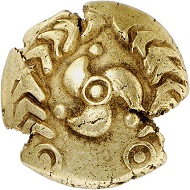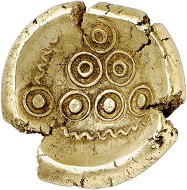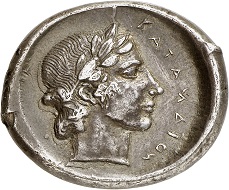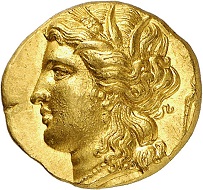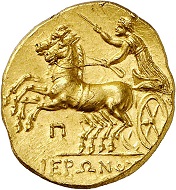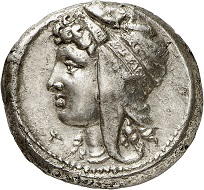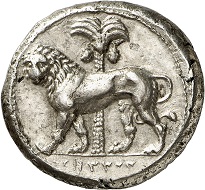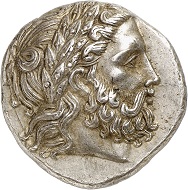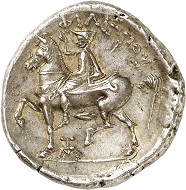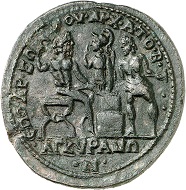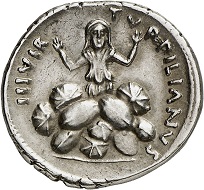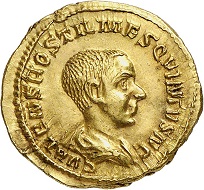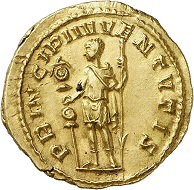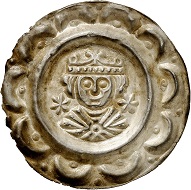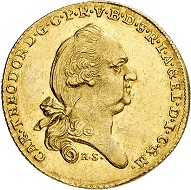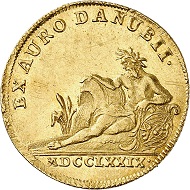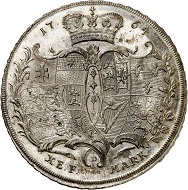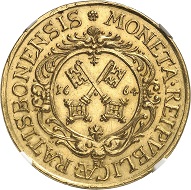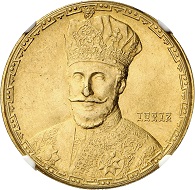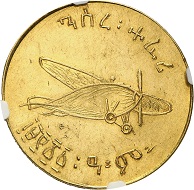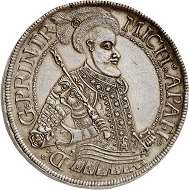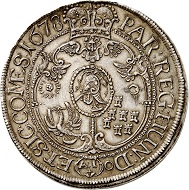10-10-2017 – 14-10-2017
Auctions 249-250, E-Auction 251
Continental Dollar at Gorny & Mosch
October 11-13, 2017, Gorny & Mosch will conduct two sales. Auction 249 focuses on ancient coins, auction 250 on world coins and medals from medieval and modern times. The three days will witness a broad selection of offers, with many rarities and something in store for every collector. The top item of the catalog of ancient coins is a Siculopunic tetradrachm featuring the head of Tanit, which used to be misinterpreted as a portrait of Dido. Among the coins from modern times, an extremely rare “Continental Dollar” stands out, which was produced in the United States of America in 1776 as the year they emerged.
For the first time, the less expensive material and the majority of multiple lots – dating from antiquity, medieval and modern times – will be called out in an e-auction, to be conducted on Sunday, October 15, 2017, starting at 10 a.m.
Auction 249 – Ancient Coins
Containing coins from the Celtic, Greek, Roman, and Byzantine era, 1105 lots with a total estimate amounting to 1.5 million euros will be offered in auction 249.
Lot 13: Celts. Hesse and Rhineland. Northern group. “Rainbow cup”, 50-25 BC. Extremely fine. Estimate: 2,500,- euros.
Celtic coins
The auction will start with 24 Celtic coins, among them some rainbow cups with estimates ranging from 1,500 euros to 2,500 euros, as well as an extremely fine imitation of the tetradrachms of the “Kroisbach mit Reiterstumpf” type of Philip II (22, EF, estimate: 1,500 euros).
Lot 91: Catane (Sicily). Tetradrachm, 430-425, unsigned work by “Kra”. From the Pozzi Collection and the Lockett Collection. Very rare. Very fine. Estimate: 5,000,- euros.
Greek coins
The Greek coins come up with a whole number of strikings, both of an exceptional style and with an exquisite provenance, for instance a tetradrachm from Catane on an unusually broad planchet, an unsigned work by “Kra”, that once formed part of the Pozzi Collection and later belonged to the Lockett Collection (91, VF, estimate: 5,000 euros).
Lot 123: Syracuse (Sicily). Hieron II, 274-216 BC. Hemistater, ca. 220-217. Extremely fine. Estimate: 5,000,- euros.
How great the artistic skills of the Syracusan die cutters were, can be seen even on coins with the tiniest diameter which is illustrated by a golden hemistater of Hieron II dating from 220-217 (123, EF, estimate: 5,000 euros).
Lot 130: Siculopunians (Sicily). Tetradrachm, ca. 320-310. Very fine+. Estimate: 25,000,- euros.
The obverse of a Siculopunic tetradrachm, struck between 320-310 BC, features a Punic goddess – probably Tanit although Astarte-Thinit, who was worshipped on Mount Eryx, is another possible candidate. Her unusual head gear gave rise to the interpretation as Dido (130, VF+, estimate: 25,000 euros).
Lot 186: Philip II, King of Macedonia. Tetradrachm, 359-355, Pella. From NFA (1985), No. 68. Extremely fine. Estimate: 5,000,- euros.
Anybody looking for perfection will be enchanted by a tetradrachm from Pella, minted during the lifetime of Philip II of Macedonia. It features an outstanding depiction of Zeus, his facial features carved with a great attention to detail. The piece was first auctioned at NFA in 1985 (186, EF, estimate: 5,000 euros).
A tetradrachm of Antigonos Doson is another top-class representative of the very coin type (217, FDC, estimate: 5,000 euros). To stay with Macedonia just a little bit longer: The next remarkable coin is a rare portrait tetradrachm of Philip V featuring Athena hurling a thunderbolt on the reverse (218, VF-EF, estimate: 5,000 euros).
Lot 234: Thebes (Boiotia). Stater, ca. 395-338. Struck under Epaminondas. Very fine. Estimate: 750,- euros.
EP-PA reads the inscription on the reverse of a 4th-century Boiotian stater. It is highly tempting to take this as a reference to great Epaminondas who taught the Spartans the meaning of fear through his oblique order. Many researchers did in fact advocate the theory that Epaminondas was actually the responsible mint official although it’s impossible to present an ultimate proof (234, VF, estimate: 750 euros).
A small selection of Ptolemaic gold concludes this part of the sale of Greek coins. There are an octodrachm featuring the portrait of Arsinoe II (381, EF+, estimate: 15,000 euros), two tetradrachms of Ptolemaios II Philadelphos with his sister and his parents (382/3, EF-FDC, and EF+, estimate: 7,000 and 7,500 euros), and an octodrachm of Ptolemaios IV Philopator (385, FDC, estimate: 9,500 euros).
Lot 436: Ancyra (Galatia). Philippus I. Bronze. Extremely fine. Estimate: 1,500,- euros.
Roman provincial coins
The section of Roman provincial coins offers a whole series of rarities, including a bronze coin from Prusa with the portrait of Pertinax (420, VF +, estimate: 1,200 euros) and a bronze coin from Ancyra featuring Hephaistos forging new weapons for Achilles (436, EF, estimate: 1,500 euros).
A bronze fraction bearing the portrait of Vespasian the Younger (430, VF, estimate: 1,200 euros) is particularly interesting. Even distinguished experts on the biographies of the Roman emperors are not familiar with this Caesar which may be due to the fact that he held this position for no longer than a few months. Early in AD 95, Emperor Domitian adopted him, only to get rid of him, without attracting a great deal of attention, after a (fabricated?) plot in May of the same year.
Connoisseurs of Alexandrian coinage will be enthralled by the grades of three rare coins from this area: the tetradrachms of Severus Alexander with his mother Julia Mamaea (449, EF, estimate: 2,000 euros), of Gordian I (450, EF, estimate: 3,000 euros), and of Pupienus (451, almost EF, estimate: 2,500 euros).
Lot 516: Augustus, 27 BC – AD 14. Denarius, 19 BC. Extremely fine. Estimate: 3,500,- euros.
Roman coins
Rarities made of gold, silver, and bronze are among the material offered in auction 249, with the strikings dating from Roman Republican and Roman Imperial times. Examples graded extremely fine include: a denarius of C. Numitorius (462, VF, estimate: 2,500 euros), and a denarius of L. Pinarius Scarpus from 31 BC, featuring Jupiter Ammon (501, VF-EF, estimate: 2,500 euros).
A small selection of coins of Augustus kicks off the sale’s department of Roman Imperial coins with the lionshare being aurei and denarii with historically interesting depictions in an exquisite grade, such as an extremely fine denarius of P. Petronius Turpilianus featuring Tarpeia (516, EF, estimate: 3,500 euros).
Lot 892: Hostilian, as Caesar, 251. Aureus. Extremely fine. Estimate: 28,000,- euros.
Be it illustrations of architecture, like the Circus Maximus (761, EF, estimate: 3,000 euros) or the Tiber Bridge (764, EF+, estimate: 7,000 euros), be it rare emperors, like Pacatianus (885, almost EF, estimate: 3,000 euros), or rare busts oriented to the left, like the one of Hadrian on his rare aureus (639, EF+, estimate: 10,000 euros) – every special wish will be fulfilled.
A particular emphasis is placed on 3rd- and 4th-century gold coins, for instance the aureus of Hostilianus as Caesar (892, EF, estimate: 28,000 euros). An aureus of Aurelian will attract the connoisseur’s attention; it became a piece of jewelry through its diatretum framing (907, EF, estimate: 12,000 euros).
Let‘s leave the Roman part of this auction with a final look at the flawless aureus of Maximinus Daia (932, EF-FDC, estimate: 10,000 euros), and a likewise perfect solidus of Magnus Maximus from Trier (962, FDC, estimate: 14,000 euros).
Byzantine coins
The fans of Byzantine coinage will be offered numerous rarities, too, such as aurei of Justinian II and Empress Irene.
Lot 2030: Donauwörth. Philip – Otto IV – Friedrich II, 1198-1208-1215-1250. Bracteate. 2nd known specimen on the market. Extremely fine. Estimate: 4,000,- euros.
Auction 250 – Medieval and Modern Times
A wealth of rare and spectacular coins from medieval and modern times can be found in sale 250, the total estimate amounting to almost 1.3 million euros.
Coins from medieval times
The roughly 70 lots present extremely rare strikings which include nothing less than a completely new type: a dünnpfennig (thin pfennig) featuring Henry VI, presumably struck in Augsburg or Donauwörth (2005, EF, estimate: 3,000 euros). Altogether, 10 bracteates come from Donauwörth, among them great rarities such as a bracteate of Henry VI (2028, EF, estimate: 5,000 euros) and another one featuring the bust of an unknown king from 1198-1250 (2030, EF, estimate: 4,000 euros) as the second known specimen available on the market.
Lot 2150: Bavaria. Karl Theodor, 1777-1799. Ducat made of Danube River gold, 1779, Munich. Very rare. Extremely fine to FDC. Estimate: 12,500,- euros.
German coins and medals
A range of notable rarities and smaller collections make the catalog become a must-read for the collector of German coins. The admirer of river gold will find specimens of the highest quality in this department, with the top item very likely to be a 1779 ducat made of Danube River gold. The dies for this extremely fine to FDC coin were produced by Heinrich Straub (2150, EF-FDC, estimate: 12,500 euros).
The material on offer includes nearly 125 lots comprising coins and medals of the different Braunschweig lines, comprising numerous mining coins and lösers. A 1717 Harzgold ducat of Georg I Ludwig von Braunschweig-Celle-Calenberg, for instance, is of the utmost rarity (2315, almost EF, estimate: 5,000 euros).
Lot 2432: Hanau-Münzenberg. Maria von Braunschweig, 1760-1764. Konventionstaler 1764, Hanau. Extremely rare. First strike. FDC. Estimate: 20,000,- euros.
Albeit a little bit less large, the series of coins representing Hanau-Münzenberg is nevertheless studded with rarities of the best grade imaginable. To mention only a few cases in point: two 1610 12 kreuzers pieces, a 1623 1/2 reichstaler, and, to top it all, the 1764 konventionstaler featuring the portrait of Maria von Braunschweig ruling on behalf of her son, Wilhelm IX von Hanau (2432, FDC, estimate: 20,000 euros).
Lot 2594: Regensburg. 4 ducats 1664. Very rare. Graded NGC MS63. Extremely fine to FDC. Estimate: 20,000,- euros.
This takes us right to the great many big rarities of which we can only name some of the most extraordinary:
- Lot 2355 – Breslau, Diocese. Franz Ludwig von Pfalz-Neuburg. Taler 1694, Neisse. Extremely rare. Almost FDC. Estimate: 8,000 euros
- Lot 2440 – Henneberg. 1/2 reichstaler 1696, Ilmenau. Unique. Extremely fine. Estimate: 15,000 euros
- Lot 2557 – Nuremberg. Konrad III. Reichstaler no date (1582). Extremely rare. Almost extremely fine. Estimate: 10,000 euros
- Lot 2594 – Regensburg. 4 ducats 1664. Very rare. Extremely fine to FDC. Estimate: 20,000 euros
- Lot 2778 – Trier. Clemens Wenzeslaus von Sachsen. Taler 1773, Coblenz. First strike. FDC. Estimate: 10,000 euros
- Lot 2788 – Mömpelgard. Ludwig Friedrich. Silver klippe 1630. Very rare. Extremely fine to FDC. Estimate: 8,000 euros
Lot 3231: Great Britain. George IV, 1820-1830. 5 pounds 1826, London. Only 150 specimens struck. From polished dies. Extremely fine / Extremely fine to FDC. Estimate: 25,000,- euros.
World Coins
The roughly 300 lots consisting of world coins and medals also deserve mentioning. The collector first of all discovers almost 75 lots with coins from the Holy Roman Empire, including rarities as the first taler which – in its strict numismatic sense – is actually a guldiner (2978, EF, estimate: 10,000 euros), and a 1687 double ducat of Leopold I which was struck in Graz (3011, FDC, estimate: 15,000 euros).
The French strikings impress with a very rare 24 livres piece, minted in Lille in 1793 (3188, EF-FDC, estimate: 12,500 euros) and the British do the same with a 5 pounds piece of which only 150 specimens were struck in London (3231, EF / EF-FDC, estimate: 25,000 euros).
A silver medallion of Sigismund III should not go unmentioned, either. Produced after his abdication as King of Sweden, the obverse of this striking features his crowned monogram flanked by two angels. The extremely rare striking is of the utmost historical significance (3309, VF, estimate: 7,500 euros).
Lot 3491: Ethiopia. Haile Selassie, 1930-1936 and 1941-1974. Medal 1928, Addis Abeba, on the purchase of four airplanes for an Ethiopian airforce. Very rare. Graded NGC MS63. Extremely fine to FDC. Estimate: 15,000,- euros.
Revered as Messiah by the Rastafarians, the regent of Ethiopia, Haile Selassie, acquired four airplanes in 1928 in France, as the basis for a newly-planned air-force of his country. To mark this, the gold medal was struck that is now on offer at Gorny & Mosch (3491, EF-FDC, estimate: 15,000 euros).
Lot 3425: Transylvania / Hungary. Michael Apafi, 1661-1690. Thick triple taler 1678, Carlsburg. Probably unique. Extremely fine. Estimate: 20,000,- euros.
Transylvania
A small selection of Transylvania constitutes one of the highlights of sale 250. Among its 17 lots are some very distinct rarities: two perfect early ducats of Christopher Bathory dating from 1580 and 1591, a 1 1/2 taler klippe from 1605, a 1646 ducat of George Rakoczy, a 1659 taler of Achatius Barcsai, and a 1684 ducat of Michael Apafi.
Struck in Clausenburg in 1678, a unique dicktaler (thick taler) of Michael Apafi, makes the unchallenged top-item in this section (3425, EF, estimate: 20,000 euros).
An icon of American coinage
“Continental Dollar”, this the popular name of an icon of US American coinage, to cross the auction block in Gorny & Mosch sale 250. This is actually the first coin ever issued in the newly-founded United States. Thomas Jefferson exerted a strong influence on the design. He is said to have come up with the idea to depict the states of the young community as links of a massive chain. Graded MS 60 by NGC, the coin is estimated at 40,000 euros.
Auction 251 – E-Auction
On Sunday, October 15, 2017, Gorny & Mosch will conduct an e-auction with ancient to world coins and medals. The material on offer has collector-friendly estimates, which also holds true for the great number of multiple lots – a specialty of Gorny & Mosch’s. There is no accompanying catalog. You can find all lots online only.
All catalogs can be ordered from Gorny & Mosch, Giessener Münzhandlung, Maximiliansplatz 20, D-80333 Munich, phone +49 / (0)89 / 24 22 643-0, fax +49 / (0)89 / 22 85 513. They can also be viewed online:
Auction 249
Auction 250





